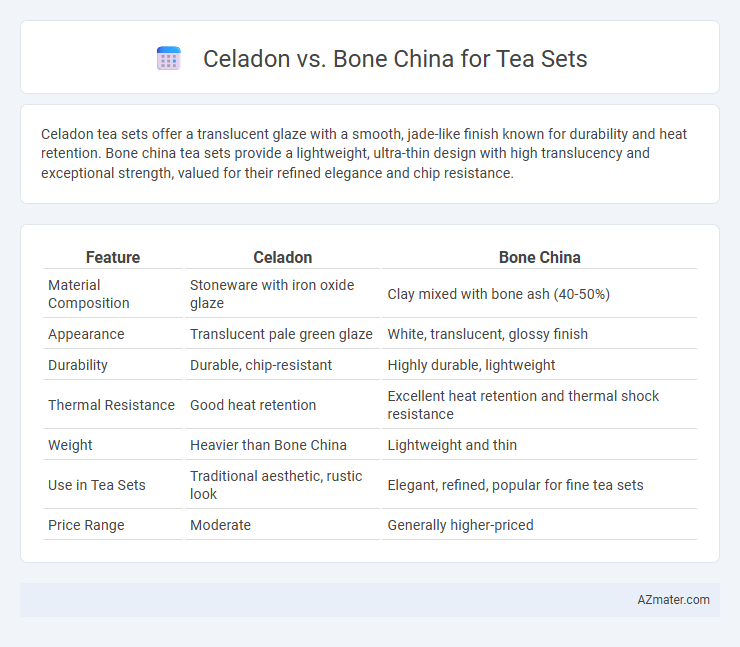Celadon tea sets offer a translucent glaze with a smooth, jade-like finish known for durability and heat retention. Bone china tea sets provide a lightweight, ultra-thin design with high translucency and exceptional strength, valued for their refined elegance and chip resistance.
Table of Comparison
| Feature | Celadon | Bone China |
|---|---|---|
| Material Composition | Stoneware with iron oxide glaze | Clay mixed with bone ash (40-50%) |
| Appearance | Translucent pale green glaze | White, translucent, glossy finish |
| Durability | Durable, chip-resistant | Highly durable, lightweight |
| Thermal Resistance | Good heat retention | Excellent heat retention and thermal shock resistance |
| Weight | Heavier than Bone China | Lightweight and thin |
| Use in Tea Sets | Traditional aesthetic, rustic look | Elegant, refined, popular for fine tea sets |
| Price Range | Moderate | Generally higher-priced |
Introduction to Celadon and Bone China
Celadon tea sets are renowned for their jade-like translucent glaze and smooth texture, originating from ancient Chinese pottery traditions. Bone china, composed of bone ash with kaolin and feldspar, boasts exceptional strength and a delicate, translucent quality ideal for refined tea drinking. Both materials offer unique aesthetic and functional qualities that enhance the tea experience.
Historical Overview of Celadon and Bone China
Celadon pottery traces its origins to the Eastern Han Dynasty (25-220 AD) in China, renowned for its jade-like glaze and subtle green hues symbolizing elegance and refinement. Bone china emerged in 18th-century England, developed by Josiah Spode, blending bone ash, kaolin, and feldspar to create a translucent, durable ceramic favored for fine tea sets. Both materials reflect distinct cultural heritages and technological advances, with celadon embodying ancient Asian artistry and bone china representing European innovation in porcelain craftsmanship.
Material Composition Differences
Celadon tea sets are crafted from high-fired stoneware clay containing a mix of kaolin, feldspar, and quartz, giving them a durable, slightly translucent body with a characteristic greenish glaze. Bone China tea sets incorporate bone ash combined with kaolin and feldspar, resulting in a lighter, more translucent material that is prized for its strength and delicate appearance. The key material composition difference lies in bone ash content, which enhances whiteness and translucency in Bone China, whereas Celadon relies on iron oxide in its glaze for its signature jade-like finish.
Aesthetic Appeal and Visual Qualities
Celadon tea sets feature a soft, translucent glaze with subtle green or blue hues, offering an elegant, minimalist aesthetic that complements natural or rustic settings. Bone china tea sets present a delicate, creamy-white appearance with a smooth, glossy finish, often enhanced by intricate patterns or gold accents, embodying classic sophistication. The translucent quality of bone china contrasts with celadon's matte or satin glaze, allowing each to appeal to different tastes in tea set aesthetics.
Durability and Strength Comparison
Celadon tea sets, crafted from high-fired stoneware, offer notable durability and resistance to chipping, making them suitable for everyday use. Bone china, composed of bone ash and fired at high temperatures, is renowned for its exceptional strength despite its delicate appearance, offering superior resistance to cracking and breakage. Comparing the two, bone china provides a lighter, stronger option with enhanced durability, while celadon excels in toughness and chip-resistance due to its dense, vitrified body.
Tea Flavor Preservation and Taste Influence
Celadon tea sets, made from glazed porcelain, offer excellent heat retention and a neutral surface that preserves the tea's natural flavor without imparting any taste, making them ideal for delicate teas. Bone China, renowned for its high translucency and strength, minimally interacts with tea, ensuring the purity of taste is maintained while providing a lightweight, elegant vessel. Both materials enhance tea experience, but Celadon's slightly thicker walls contribute to slower cooling, preserving warmth and flavor depth longer than Bone China.
Heat Retention and Practical Usage
Celadon tea sets, crafted from glazed stoneware, offer moderate heat retention suitable for casual tea drinking, while bone china excels in insulation due to its porcelain composition, keeping tea warmer longer. Bone china's lightweight and translucent properties enhance practical usage by providing durability and elegance, whereas celadon's thicker walls offer sturdiness but may feel heavier. For daily use, bone china's heat retention and delicate design make it ideal for refined tea sessions, while celadon suits traditional, robust tea experiences.
Care, Maintenance, and Longevity
Celadon tea sets require gentle handwashing with mild detergent to preserve their delicate glaze and should be kept away from sudden temperature changes to prevent cracking. Bone china, known for its durability and chip resistance, also benefits from handwashing and careful handling, but it generally withstands dishwasher use better than celadon. Both materials last longer when stored properly with soft padding to avoid scratches and are best used for special occasions to maintain their pristine condition.
Price Range and Collectible Value
Celadon tea sets typically fall within a moderate price range, often between $30 and $150, making them accessible for everyday use and beginner collectors. Bone china tea sets command higher prices, ranging from $100 to over $500, reflecting their refined craftsmanship and durability, which enhances their collectible value. Collectors favor bone china for its translucent quality and historical prestige, while celadon is prized for its distinctive glaze and cultural significance in traditional East Asian ceramics.
Choosing the Best Tea Set: Celadon or Bone China
Celadon tea sets, known for their subtle jade-green glaze and durability, offer a traditional aesthetic ideal for casual or ceremonial tea drinking. Bone china tea sets, prized for their translucency, whiteness, and fine, lightweight texture, provide a luxurious experience and excellent heat retention for optimal brewing. Choosing between celadon and bone china depends on preferences for durability and rustic charm versus elegance and refined craftsmanship in tea service.

Infographic: Celadon vs Bone China for Tea Set
 azmater.com
azmater.com